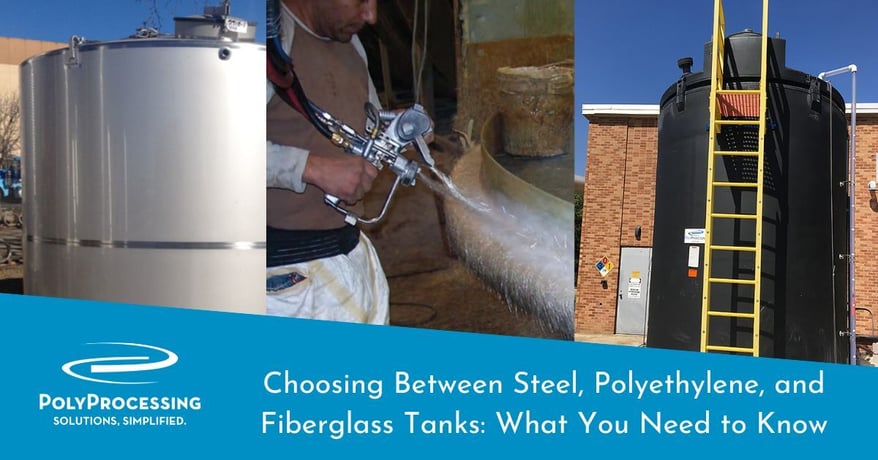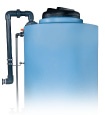Choosing Between Steel, Polyethylene, and Fiberglass Tanks: What You Need to Know
Purchasing a high-performance chemical storage tank is a significant investment for your company, and choosing the right tank for your needs isn't always an obvious decision. Whether you're considering fiberglass reinforced plastic (FRP), stainless steel, mild steel, or crosslinked polyethylene (XLPE) tanks, it's essential to understand the differences between them and to know what to expect in terms of cost, maintenance, service, delivery times, and protection.

Let’s compare all major tank materials and demonstrate why XLPE consistently outperforms traditional options across multiple criteria.
Understanding Chemical Tank Material Options
Fiberglass Reinforced Plastic (FRP) tanks are coated with an interior chemical resin, with a structural layer composed of chopped glass fiber or filament-wound fibers and resin.
Steel tanks come in two major types: mild steel (commonly used in mining for sulfuric acid storage) and stainless steel (popular in breweries and applications where aesthetic appeal matters).
Crosslinked Polyethylene (XLPE) is a thermoset resin specifically engineered for critical applications like chemical storage, offering superior performance across multiple applications.
When evaluating chemical storage options, consider these key factors:
- Performance: XLPE matches or exceeds the performance of both FRP and steel tanks across all applications.
- Cost: XLPE provides the lowest total cost of ownership, from initial purchase through lifetime maintenance.
- Reliability: Seamless construction and superior chemical resistance ensure longer service life.
- Scalability: Lower costs and faster delivery enable business growth and rapid response to market demands.
- Certification: Complete NSF/ANSI 61 system certification ensures compliance and quality.
XLPE vs. FRP Storage Tanks: Five Critical Advantages
Crosslinked polyethylene chemical tanks provide several important advantages over fiberglass tanks, especially when storing substances other than water. Let’s look at five of these advantages.
1. Seamless Construction for Greater Strength
FRP Limitations: Fiberglass tanks are filament-wound or hand laid up, creating seams that become vulnerable weak points for leaks. Manufacturers add tops and bottoms post-production, with seams that further increase leak risks.
XLPE Advantage: Crosslinked polyethylene tanks are rotationally molded as one-piece constructions with no vulnerable seams. This homogenous construction eliminates potential weak spots and prevents wicking or delamination from chemical attack.
2. Superior Chemical Resistance
FRP Vulnerability: Harsh chemicals can wick into fiberglass tank walls over time, compromising the interior resin barrier and eventually reaching the structural area. This causes fiber breakdown and tank failure.
XLPE Protection: Even the harshest chemicals cannot seep into high-density crosslinked polyethylene tank walls, which ensures long-term integrity and performance.
3. Lower Total Cost of Ownership
FRP Costs: Fiberglass tanks cost three to five times more than XLPE tanks, with delivery times that are three to four times longer. They require regular maintenance, recoating, and UV protection for outdoor installations.
XLPE Savings: Lower upfront costs, minimal maintenance requirements, and no need for painting or coating (UV additives can be integrated throughout the tank wall).
4. Enhanced Durability and Handling
FRP Fragility: Fiberglass tanks are inflexible and vulnerable to cracking. They require extreme care during movement and installation. These tanks often need special wicking mats to detect bottom leaks.
XLPE Durability: XLPE chemical storage thanks are much more durable and easily movable. Poly Processing's durability tests drop semi-filled tanks from 45 feet without structural failure.
5. Advanced Fitting Technology
FRP Attachments: All fittings are added post-production, creating potential leak points at each attachment site.
XLPE Innovation: Poly Processing's IMFO® (Integrally Molded Flanged Outlet®) fittings are molded directly into the tank, eliminating stress points and leak opportunities.
XLPE vs. Steel Tanks: Performance at a Fraction of the Cost
Mild Steel Limitations
Mild steel tanks work well for high-concentration sulfuric acid (98%), but they become vulnerable to corrosion when acid concentration drops below 93%. This significantly compromises tank life expectancy in many applications.
XPLE advantages over mild steel tanks include:
- Cost Effectiveness: XLPE tanks cost a fraction of comparable steel tanks while delivering equal or superior performance.
- Faster Delivery: 7-9 week delivery vs. 30+ weeks for stainless steel.
- Seamless Construction: No welded seams means no weak points.
- Superior Chemical Compatibility: XLPE handles sulfuric acid at various concentration levels, unlike mild steel's limitations.
Stainless Steel: Aesthetic but Expensive
While stainless steel tanks offer aesthetic appeal for breweries and public-facing applications, they come with significant drawbacks:
- Cost: Two to three times more expensive than XLPE
- Delivery time: 30+ weeks vs. 7-9 weeks for XLPE
- Seam vulnerabilities: A 6,000-gallon stainless steel tank can have up to 70 yards of welded seams
- Limited scalability: Higher costs make scaling operations more challenging
Industry-Specific Chemical Storage Applications
XLPE tanks provide ideal chemical storage solutions across a wide range of industry applications. Here are a few industries where crosslinked polyethylene tanks provide superior performance.
Breweries
For small-batch, fast-growing craft brewery operations, XLPE tanks enable quick scaling and market responsiveness. They're cost-effective, quickly manufactured, and available in various sizes from 55-gallon to 15,500-gallon capacities.
Clean-in-Place Applications
XLPE tanks with OR-1000® systems and specialty food and beverage grade fittings provide customized clean-in-place storage solutions for high-purity acids and cleaning agents.
Caustic Soda Storage
Poly Processing's SAFE-Tank® System offers the same corrosion resistance as stainless steel while providing:
- Lower initial and long-term costs
- Smaller footprint (eliminates concrete berm requirements)
- Chemical conservation through double-wall leak containment
- Easy temperature maintenance with integrated heating systems
Mining and Industrial Applications
XLPE tanks excel in storing sulfuric acid at various concentrations, providing unmatched chemical resistivity and engineered load tolerances for heavy-weight chemicals in the mining industry.
NSF/ANSI 61 Certification Leadership
Most FRP tanks hold basic NSF/ANSI 61 certification for only potable water applications. Poly Processing is the only chemical storage tank manufacturer with complete NSF/ANSI 61 system certification, covering:
- 38 of the most popular water treatment chemicals
- XLPE tanks or XLPE tanks with OR-1000® Systems
- All associated fittings and components
Chemical Tank Delivery and Service Excellence
While most FRP and steel manufacturers quote 24-40 week delivery windows, Poly Processing consistently delivers within 8-10 weeks. You get:
- Transparent pricing and lead times
- Reliable, consistent service
- Peace of mind for project planning
Make the Right Choice for Your Business
While steel tanks may offer aesthetic appeal and FRP tanks have traditional market presence, crosslinked polyethylene consistently delivers superior performance, lower costs, and greater reliability. For businesses seeking the best value in chemical storage, XLPE is the clear choice.
XLPE tanks provide the same or better performance as traditional materials while offering significant advantages in cost, delivery time, durability, and maintenance requirements. Choose the tank material that delivers the best long-term value for your operation.
Download our comprehensive tank buying guide. Explore detailed comparisons and find the perfect storage solution for your specific needs.
- November 3, 2025
- Topics: Tank Design and Materials
About Poly Processing
Posts By Topic
Tech Talk Podcast Episodes
Subscribe By Email
Recent Posts
- Maximizing Fill Efficiency: Selecting the Optimal Fill Line System
- Chemical Storage Tanks: A Quick Guide for End Users
- Popular Customization Options for Chemical Storage Tanks
- Understanding Flood Zones Under the IBC: Building Requirements and Insurance Implications
- Choosing Between Steel, Polyethylene, and Fiberglass Tanks: What You Need to Know
Tank Configurator

Find the recommended tank and system components for your chemical storage challenge.
Configure a Tank Package










